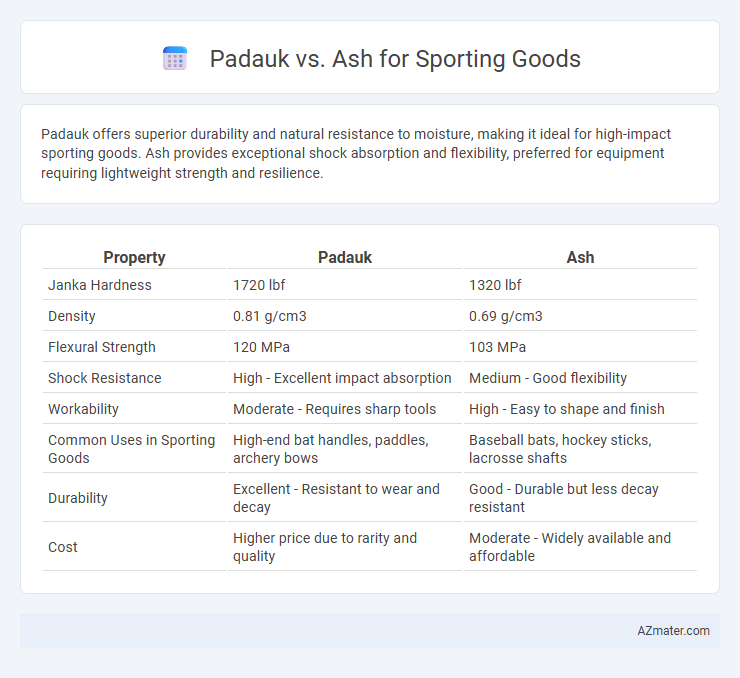Padauk offers superior durability and natural resistance to moisture, making it ideal for high-impact sporting goods. Ash provides exceptional shock absorption and flexibility, preferred for equipment requiring lightweight strength and resilience.
Table of Comparison
| Property | Padauk | Ash |
|---|---|---|
| Janka Hardness | 1720 lbf | 1320 lbf |
| Density | 0.81 g/cm3 | 0.69 g/cm3 |
| Flexural Strength | 120 MPa | 103 MPa |
| Shock Resistance | High - Excellent impact absorption | Medium - Good flexibility |
| Workability | Moderate - Requires sharp tools | High - Easy to shape and finish |
| Common Uses in Sporting Goods | High-end bat handles, paddles, archery bows | Baseball bats, hockey sticks, lacrosse shafts |
| Durability | Excellent - Resistant to wear and decay | Good - Durable but less decay resistant |
| Cost | Higher price due to rarity and quality | Moderate - Widely available and affordable |
Introduction to Padauk and Ash Woods
Padauk wood, prized for its vibrant reddish-orange hue and exceptional durability, offers remarkable shock resistance and stability, making it an ideal choice for sporting goods requiring resilience and strength. Ash wood, known for its light color, flexibility, and excellent impact absorption, has long been favored in the production of baseball bats and other sports equipment due to its superior elasticity and lightweight nature. Both woods provide essential performance characteristics, with Padauk excelling in hardness and wear resistance while Ash offers outstanding tensile strength and flexibility for dynamic athletic use.
Physical Properties Comparison: Padauk vs Ash
Padauk wood exhibits higher density, typically around 700 kg/m3, offering superior durability and impact resistance compared to Ash, which averages 650 kg/m3. Ash is valued for its excellent flexibility and shock absorption, with a modulus of elasticity near 12 GPa, making it ideal for items like baseball bats. Padauk's hardness rating reaches approximately 1,720 on the Janka scale, significantly surpassing Ash's 1,320, providing enhanced wear resistance for demanding sporting applications.
Appearance and Aesthetic Appeal
Padauk wood features a vibrant reddish-orange hue that deepens over time, offering a striking and exotic appearance ideal for high-visibility sporting goods. Ash wood displays a lighter, creamy color with a pronounced straight grain, providing a classic and clean aesthetic favored in traditional sports equipment. The bold color contrast of Padauk enhances visual appeal, while Ash's uniform texture allows for intricate shaping and smooth finishes.
Durability and Strength: Which Wood Performs Better?
Padauk wood's high density and natural oils impart exceptional durability and resistance to wear, making it highly suitable for sporting goods that demand longevity and toughness. Ash offers superior shock resistance and flexibility, ideal for equipment like baseball bats and hockey sticks where impact absorption is critical. While Padauk excels in hardness and decay resistance, Ash provides better strength-to-weight ratio and elasticity, often making it the preferred choice for dynamic sports applications.
Weight and Balance in Sporting Equipment
Padauk, known for its density around 720-800 kg/m3, offers a heavier feel than Ash, which typically ranges between 600-700 kg/m3, providing more mass for impact absorption in sporting goods like baseball bats. Ash's lighter weight and natural elasticity contribute to superior balance and swing speed, enhancing control and responsiveness in equipment such as hockey sticks and tennis rackets. Choosing between Padauk and Ash depends on the desired balance between power and maneuverability in sporting applications.
Workability and Manufacturing Considerations
Padauk offers excellent workability with its fine grain and natural oils, making it easy to machine and finish for sporting goods like baseball bats and archery equipment. Ash features superior shock resistance and flexibility, with a straight grain that simplifies shaping and sanding during manufacturing. Both woods provide durability, but Ash's consistent stiffness is often favored for high-impact sports applications requiring precise performance.
Impact on Performance: Real-World Applications
Padauk's dense and shock-resistant properties enhance durability and power in sporting goods like baseball bats and hockey sticks, promoting superior energy transfer and reduced vibration. Ash, known for its elasticity and lightweight strength, offers excellent flexibility and control, making it ideal for baseball bats and tennis rackets requiring quick maneuverability. Real-world applications show Padauk improves impact force and longevity, while Ash optimizes control and swing speed, directly influencing athlete performance depending on sport-specific demands.
Cost and Availability for Sporting Goods
Padauk offers moderate cost and good availability, making it a practical choice for sporting goods requiring durability and a distinctive reddish hue. Ash is generally more affordable and widely available, favored for its impact resistance and light weight in equipment like baseball bats. Manufacturers often select Ash to balance cost efficiency and performance, while Padauk caters to niche markets prioritizing aesthetics and strength.
Sustainability and Environmental Impact
Padauk wood is highly regarded for sporting goods due to its exceptional durability and natural resistance to decay, sourced primarily from tropical regions with established sustainable forestry practices. Ash wood offers a renewable option with fast growth rates and widespread availability, supporting lower environmental footprints and responsible harvesting initiatives. Both woods contribute to sustainable sporting equipment, but Padauk's density provides enhanced longevity, while Ash's rapid regeneration favors ecological balance.
Which Wood to Choose: Padauk or Ash for Sporting Goods?
Padauk offers superior durability and vibrant color, making it ideal for sporting goods that require both strength and aesthetic appeal. Ash provides excellent shock absorption and flexibility, preferred for items like baseball bats and hockey sticks that demand resilience and performance. Choosing between Padauk and Ash depends on the balance needed between toughness and elasticity for specific sporting applications.

Infographic: Padauk vs Ash for Sporting Good
 azmater.com
azmater.com